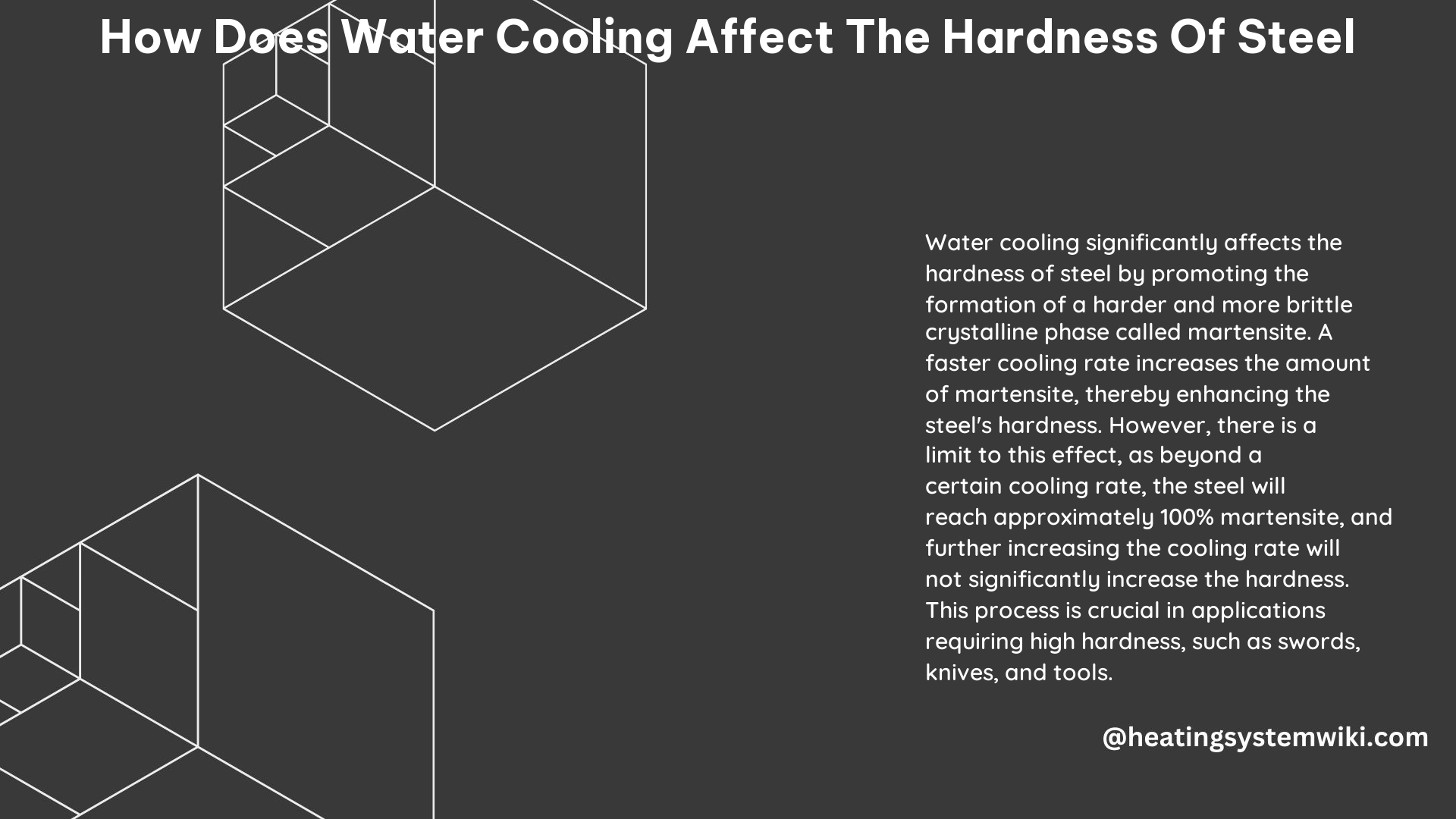Water cooling can significantly impact the hardness of steel by altering the metal’s solid phase during the heat treatment process. When steel is rapidly cooled, it transitions from the austenite phase to the martensite phase, increasing the material’s hardness. This process, known as quenching, is commonly used to harden steel for various applications, such as swords, knives, and tools.
Cooling Rate and Hardness
The cooling rate is a crucial factor in determining the final hardness of steel. The faster the cooling rate, the higher the hardness achieved. This is because the rapid cooling promotes the formation of the martensite phase, which has a higher hardness compared to other steel microstructures.
| Quenchant | Cooling Rate (°C/s) | Hardness |
|---|---|---|
| Brine | 100-200 | Highest |
| Water | 25-100 | High |
| Oil | 10-25 | Moderate |
| Air | 0.1-10 | Lowest |
As shown in the table, brine provides the fastest cooling rate, resulting in the highest hardness, while air cooling is the slowest, leading to the lowest hardness. Oil quenching offers a medium-slow cooling rate, resulting in moderate hardness and less thermal stress, making it a preferred choice for many applications.
Quenchant Temperature and Hardness

The temperature of the water quenchant can also significantly impact the cooling process and the resulting hardness. The optimal quenchant temperature depends on the specific steel grade being treated.
For example, for a medium-carbon steel, the recommended quenchant temperature range is typically between 20°C and 60°C. Temperatures outside this range can lead to issues such as:
- Temperatures below 20°C: Increased risk of cracking due to excessive thermal stress.
- Temperatures above 60°C: Reduced cooling rate, resulting in lower hardness.
It is essential to carefully control the quenchant temperature to ensure the desired hardness is achieved while minimizing the risk of distortion, cracking, or soft spots in the steel part.
Quenching Time and Hardness
The duration of the quenching process can also affect the hardness and overall quality of the steel part. The optimal quenching time depends on factors such as the steel grade, part size, and quenchant temperature.
As a general guideline, the quenching time should be long enough to ensure the entire part has reached the desired temperature and undergone the phase transformation to martensite. However, excessively long quenching times can lead to issues such as:
- Increased thermal stress and risk of cracking or distortion.
- Potential for the formation of undesirable microstructures, such as bainite or pearlite, which can reduce hardness.
Careful monitoring and adjustment of the quenching time are necessary to achieve the desired hardness while maintaining the integrity of the steel part.
Thermal Stress and Hardness
Rapid cooling during the quenching process can introduce significant thermal stress in the steel part. This thermal stress can lead to distortion, cracking, or the formation of soft spots, which can compromise the overall hardness and performance of the steel.
To mitigate these issues, it is crucial to control the cooling rate and ensure that the quenchant temperature is appropriate for the specific steel grade being treated. Additionally, the use of a quenching tank or other specialized equipment can help ensure even cooling and reduce the risk of thermal stress-related defects.
Safety Considerations
Working with steel and heat treatment processes, including water cooling, can be hazardous. It is essential to follow established safety guidelines and use appropriate personal protective equipment (PPE) to minimize the risks. Some key safety considerations include:
- Proper handling and storage of hot steel parts.
- Adequate ventilation and fume extraction in the work area.
- Use of heat-resistant gloves, face shields, and other PPE.
- Proper training and supervision for anyone involved in the heat treatment process.
By prioritizing safety and following best practices, DIY enthusiasts and professionals can safely experiment with water cooling to alter the hardness of steel and achieve the desired results.
References:
- American Welding Society Forum – Weld Rejection Do to Rapid Cooling by Water
- Fusion Chemical – The Definitive Guide: Quenching in Oil vs. Water
- BYJU’S – How Does The Rate Of Cooling Affect The Hardness Of The Metal?
- Reddit – If rapidly cooling a metal increases its hardness, does the speed at which it’s cooled always affect the end result (in terms of hardness)?
- Thermal Processing Magazine – Using water as a quenchant
